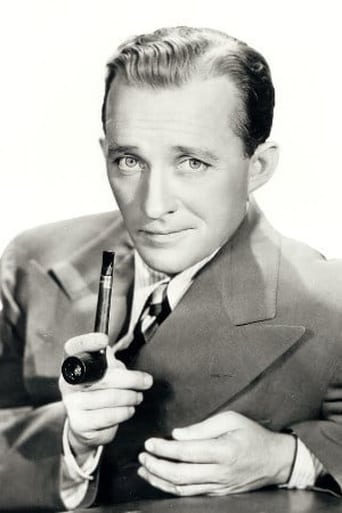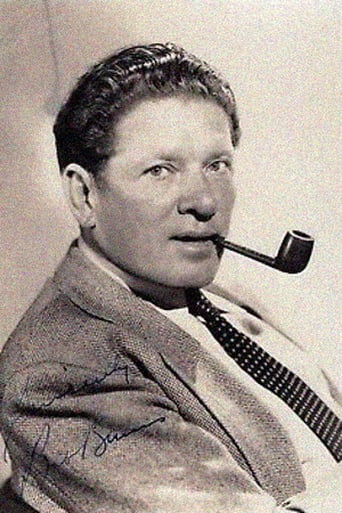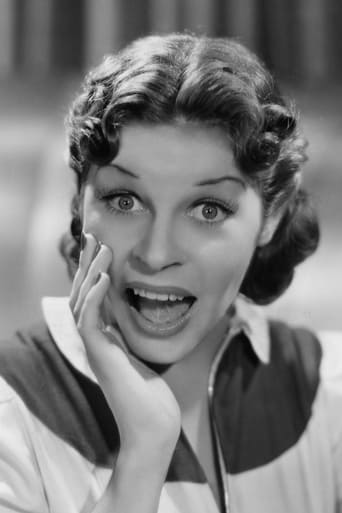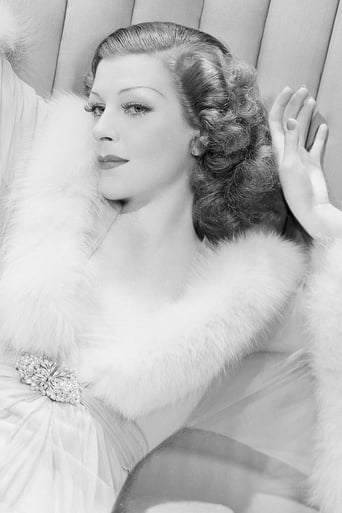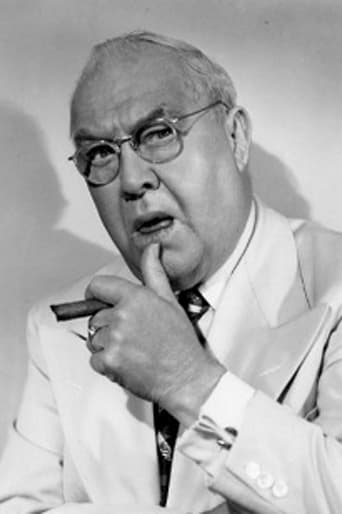Mjeteconer
Just perfect...
Beanbioca
As Good As It Gets
Portia Hilton
Blistering performances.
Rosie Searle
It's the kind of movie you'll want to see a second time with someone who hasn't seen it yet, to remember what it was like to watch it for the first time.
vincentlynch-moonoi
This film -- like most of Bing's films from the 1930s -- is eclipsed from the bigger budget Crosby films of the 1940s. Nevertheless, this is a rather pleasant diversion that includes several Hawaiian themed songs that were forever thereafter associated with Crosby.Here, Crosby plays a publicity agent for a pineapple company whose latest publicity stunt -- a young lady (Shirley Ross) from the continental United States -- is chosen as the "Pineapple Girl" and is given "3 romantic weeks" in Hawaii; which she finds rather rather dissatisfying and she decides to head back stateside, thus ruining the publicity campaign. Crosby to the rescue, but he misidentifies the girl in question, thinking it is Martha Raye. Meanwhile, by pure coincidence, he falls in love with Ross, not knowing she is the actual "Pineapple Girl".There's a lot of nonsense about a sacred pearl stolen from a local shrine. It's kind of a dead end part of the plot, although it does give us a chance to see a very young Anthony Quinn as a native Hawaiian. There's more nonsense about a pig. Don't ask.In the end -- of course -- Crosby wins Ross, only then finding out she is the real "Pineapple Girl".Among the great songs here are "Blue Hawaii" and "Sweet Leilani".Crosby is...well...Crosby. No great acting here. Just the pleasant personality audiences enjoyed back then. Ross is fairly good here, too. Martha Raye contributes her comic relief. Bob Burns, as Crosby's buddy, also provides comic relief...although I found him more annoying than humorous.It's a decent film. Better than "Double Or Nothing", which is often on the same DVD disc. Probably more for Crosby fans, although the on location outdoor photography makes the Hollywood scenes believable as Hawaii in the 1930s.
weezeralfalfa
The film credits omitted one of the main players: Wolford: Arkansas bumpkin Bob Burn's pet mini pig, who accompanies him everywhere and is frequently seen throughout. Zany Martha Raye even claimed he won first prize in a dog show, to pay for Bob's jail bail. This was the second and last film pairing of Martha and Bob, again cast as an impromptu pair of slow-witted clowns. Unlike their first pairing, Bob doesn't get to play his unique 'bazooka' musical instrument, thus Wolford serves as his unusual 'prop'. When the stolen sacred necklace the gang is trying to return to the natives is dropped by butterfingers Georgia Smith(Shirley Ross), it lands around Wolford's neck, below. Startled, he runs off into the forest. Bob gives a sampling of his 'championship' hog calling talent, resulting in the appearance of a mob of pigs, along with Wolford. When Martha tries to imitate Bob, it sounds like Johnny Weismuller's Tarzan call, and the pigs all scatter.As in her first Paramount film, Martha gets to do one of her zany vaudeville-styled songs, entitled "Okolehau", which is the name of the native alcoholic drink, usually made from tubers of the Ti shrub, which was also very important in providing leaves for their roofs and skirts. Martha had a good swing of this liquor before her performance, as part of the celebration surrounding the return of the stolen black pearl necklace. It was hoped this would placate the angry spirit causing Pelee volcano to rumble. but Pelee blew her top anyway, causing the native priest to declare the necklace a fake. Incidentally, the infamous Pelee , which 'blew its top' in 1902, killing many thousands, is in the eastern Caribbean, not Hawaii, where the volcanoes spew non-explosive magma, having little dissolved gases, which are the cause of explosive eruptions.Judging by their names,probably few of the 'natives' were genuine, or at least were not full-blooded. This includes a young Anthony Quinn. Nonetheless, most do come across as genuine, and we are treated to a number of festivals, with much singing and dancing. The actors never got to Hawaii, the film being shot mostly in the LA Arboretum or studio. However, periodically, clearly we do have shots of the real Hawaii in the background.The screen play often makes little sense. Why did Bing, as publicity manager of a Pineapple firm, have to reach to Birch Falls,Iowa, to find a 'Pineapple Princess', flown in for a 3 week publicity campaign, promised a romantic time, as well??. It's never explained why Martha apparently accompanied her, as her roommate? Soon after arriving, Georgia inexplicably complains she is bored and is thinking of soon leaving, bad publicity for Hawaii's tourism image! So, Bing is hauled off his fishing yacht, and told to do something to prevent Georgia from leaving. He organizes an evening serenade with some native men, and himself as the chief singer of "Blue Hawaii". Yes, long before Elvis claimed it as his own, this classic was composed for this film and was sung twice, as well as during the opening credits. Eventually ,Martha, not Georgia, emerges from the bungalow, enthralled that she has been serenaded, and jumps into Bob's arms. Bing is not impressed, and leaves to work on his yacht, near the ticket booth for the ocean liner China Clipper. I'm not aware of any actual ocean liner by that name, but Glenn Martin famously inaugurated trans-Pacific air service just the year before this film was made, with its three China Clippers! In fact, when Georgia's suspicious boyfriend, back in Iowa, rushes to find out what Georgia is up to, he presumably arrives via a China Clipper, seen overhead in one shot! Anyway, Bing meets Georgia while working on his boat, and they have a humorous, if inauspicious, introduction, in which he discovers that she is the real Pineapple Princess. By inadvertently getting mixed up in the stolen black pearl necklace affair, Georgia misses the ship home. Bing proceeds to make her stay memorable, beginning with a repeat of his "Blue Hawaii". Of course, when it's time to go home, she has to choose between Bing and her old stuffy boyfriend : a close call, with Bing requiring an accomplice.Ralph Rainger and Leo Robin did a commendable job with the scores, which included all but the academy award-winning "Sweet Leilani", composed a few years earlier by Hawaii-based Harry Owens, in honor of his new daughter. Bing insisted that it be included, over the vehement objections of producer Hornblow. Although memorable, I'm surprised "Blue Hawaii" didn't win the award instead! Shirely Ross(as Georgia) was also a good singer, if lacking much charisma. Besides accompanying Bing with "Blue Hawaii", she does ""In a Little Hula Heaven" on her own, and reprises "Sweet is the Word for You", after Bing initiates it, as their romance heats up. Bing also sings one song, presumably Nani Ona Pua, in the native language.I can see why some people might be put off by Martha Raye's or Bob Burn's brands of humor, as dated. It's difficult to imagine Shirley as a woman Bing would get too excited about. Plenty of the native women were better looking and more pleasant, and Martha was way more charismatic. I would have preferred Betty Grable, who was with Paramount then, grossly under-appreciated, and would be paired with Martha as sisters the following year. Despite the often nonsensical screenplay, it's mostly a fast-moving fun time.
JohnHowardReid
A mixed blessing. Bing, as usual is in fine form, and the songs are not only worth listening to because of Bing's mastery, but the Rainger-Robin numbers are reasonably attractive in their own right. Of course the stand-out is "Sweer Leilani" by Harry Owens. The story, however, is another matter. True, it starts most promisingly and for a while there it looks as if George Barbier and Grady Sutton are going to enjoy some stellar moments. But this promising sub-plot is soon all but junked in favor of a ridiculous lot of drivel about a stolen black pearl which the script writers themselves undermine when they turn it into a Clayton's affair. (For those unacquainted with liquor, the non-alcoholic Clayton's is extensively advertised as "the drink you have when you're not having a drink." Therefore a Clayton's plot is the plot you have when you're not having a plot). Poor old Anthony Quinn is cast in this segment and looks as puzzled by the script's casual turnabout as we do. Of course, if you decide midway through your movie to junk your plot, you've got to produce a substitute. This the writers promptly do. In fact, they produce two substitutes. The first is a series of strained slapstick scenes involving Martha Raye and Bob Burns, and the second a slightly more bearable but nonetheless ridiculous lot of twaddle involving Bob Burns and Leif Erickson. But the writers do have a nice trick up their sleeve for the Crosby-Ross fade-out. Unfortunately, they forgot to tell director Frank Tuttle to make sure the actress involved, Emma Dunn, played her scene tongue-in-cheek. Maybe they did tell him and Tuttle refused. Or maybe they simply assumed that Tuttle would cotton on. Anyway, as the movie now ends, thanks to Tuttle's incompetence, it leaves a sour taste in the mouth. No audience likes to feel that it's being taken for a ride and critics don't like it either. If a scene is tongue-in-cheek is supposed to be played that way. In fact, the whole movie is a tongue-in-cheek affair. Quinn is obviously aware of this. Understandably, he looks rather puzzled and plays at half steam – which is certainly a good decision, especially if you're not receiving any advice from a seemingly unaware director. Crosby, of course, just breezes trough the movie in his usual fine, casual style. And photographically, my hat's off to Robert C. Bruce who has enlivened his location material with some really captivating yachts-at-dusk footage.
oldblackandwhite
Waikiki Wedding delivers a bit more than you would expect from one of Bing Crosby's musical trifles of the 1930's. A couple of hit songs, some dynamic dance numbers, and a lot of genuinely funny, if somewhat broad, gags from rustic Arkansas comedian Bob Burns and big-mouth comedienne Martha Raye. Burns and Rae get riotous support in their department from a certain pal of theirs we'll get to later.This very likable, laid-back musical comedy is set in romantic, tuneful Hawaii, never mind the cast never actually got any closer to said Pacific isles than the Los Angeles Arboretum and Botanic Garden. If the lavishly constructed sets looked like Hawaii, who cares. The huge cast of Hawaiian natives were all natives, all right. Well, at least two or three were genuine Hawaiians, but the others were all natives -- of Mexico, Latin America, and well...Chicago, maybe. Who cares, it was such great fun! Great music, great singing by Bing and minor leading lady but major singer Shirley Ross, and the "Hawaiian" chorus. Accademy Award nominated dance direction with a terrific foot-stomping number on tom-toms by a well-constructed, Latino-looking babe. The aforementioned broad humor by Burns, Raye, and a platoon of wacky character actors led by George Barbier and a bespectacled Leif Erickson, demonstrating that he had more than a serious side.This little movie coughed up two hit songs: Accademy Award-winning Sweet Leilani, written by Harry Owens and sung by Bing and chorus, and Blue Hawaii, written by Ralf Raigner and Leo Robin and sung several times by Crosby, Ross, and chorus. While Sweet Leilani got the honors in 1937, Blue Hawaii has proved the more durable, going through several revivals the next three decades, and remaining popular even today. Miss Ross only got one solo song, A Little Hula Heaven, in which to really show what a good voice she had.Bob Burns' folksy, humorous philosophizing and Martha Raye's mugging slapstick will not be appreciated by all, especially those too sophisticated to have a good belly laugh. I liked Burns, but then I'm a hick, too. I tried not to like Martha, but I found myself laughing at her anyway. But the funniest and most charismatic character in this enjoyable picture was, without doubt, Burns' pet pig Wolford! Yours truly usually hates cutesy animals in movies (see my review of We're Not Dressing), but with two exceptions: pigs and chickens, both of which are funny no matter what they are doing. This little Wolford guy was a riot all the way! Surely that porker must have been the great-great-great-great-grandfather of Arnold Ziffel. As you listen to Bob Burns and watch the antics of Wolford, you may start feeling like you have gone to Green Acres.But never mind, there is a lot for everyone in this entertaining, well turned out Crosby musical comedy Waikiki Wedding.
